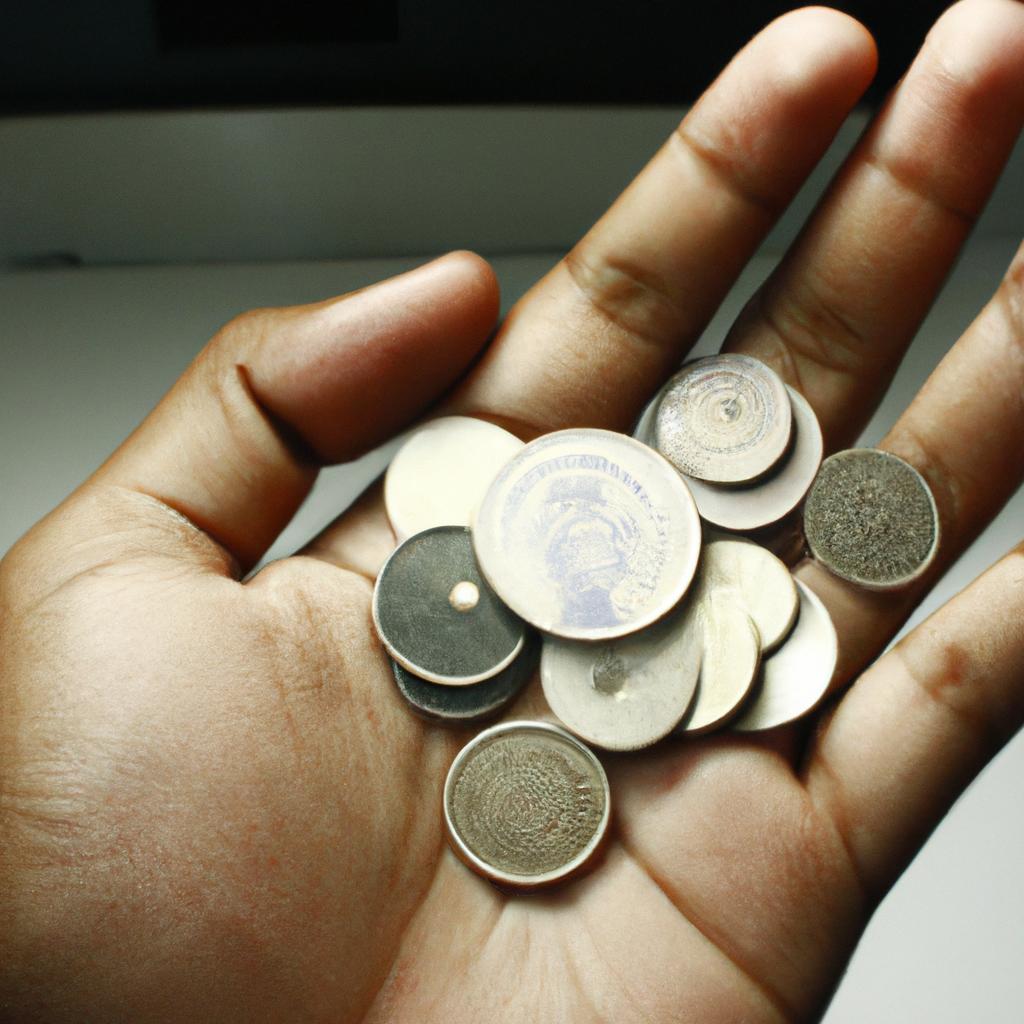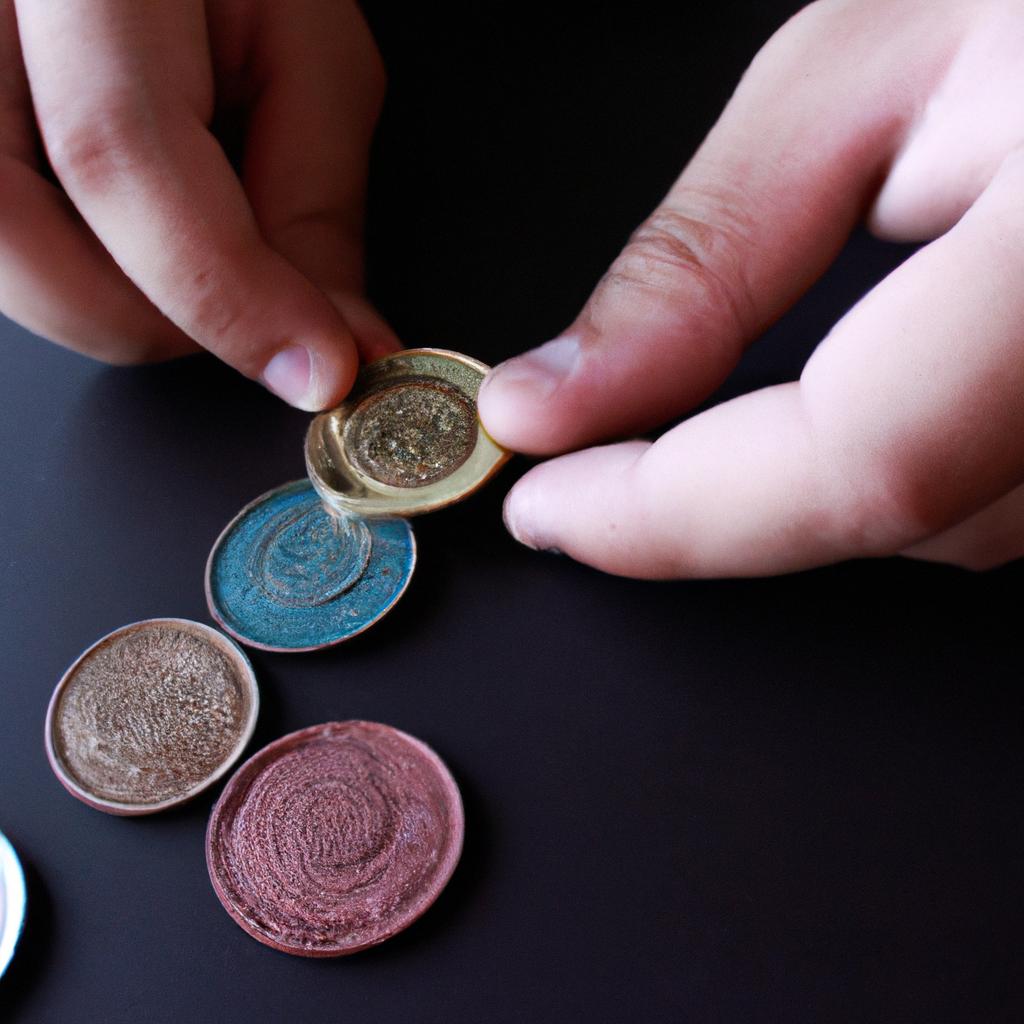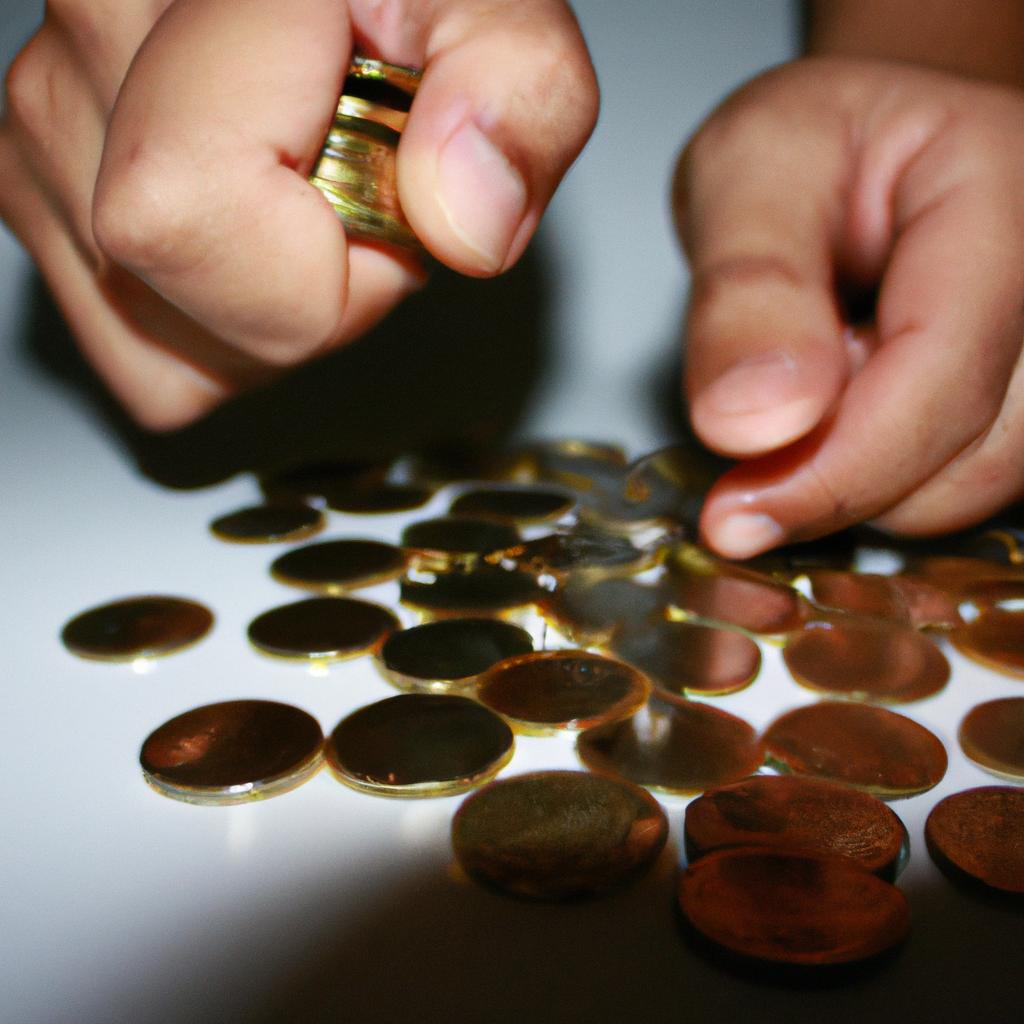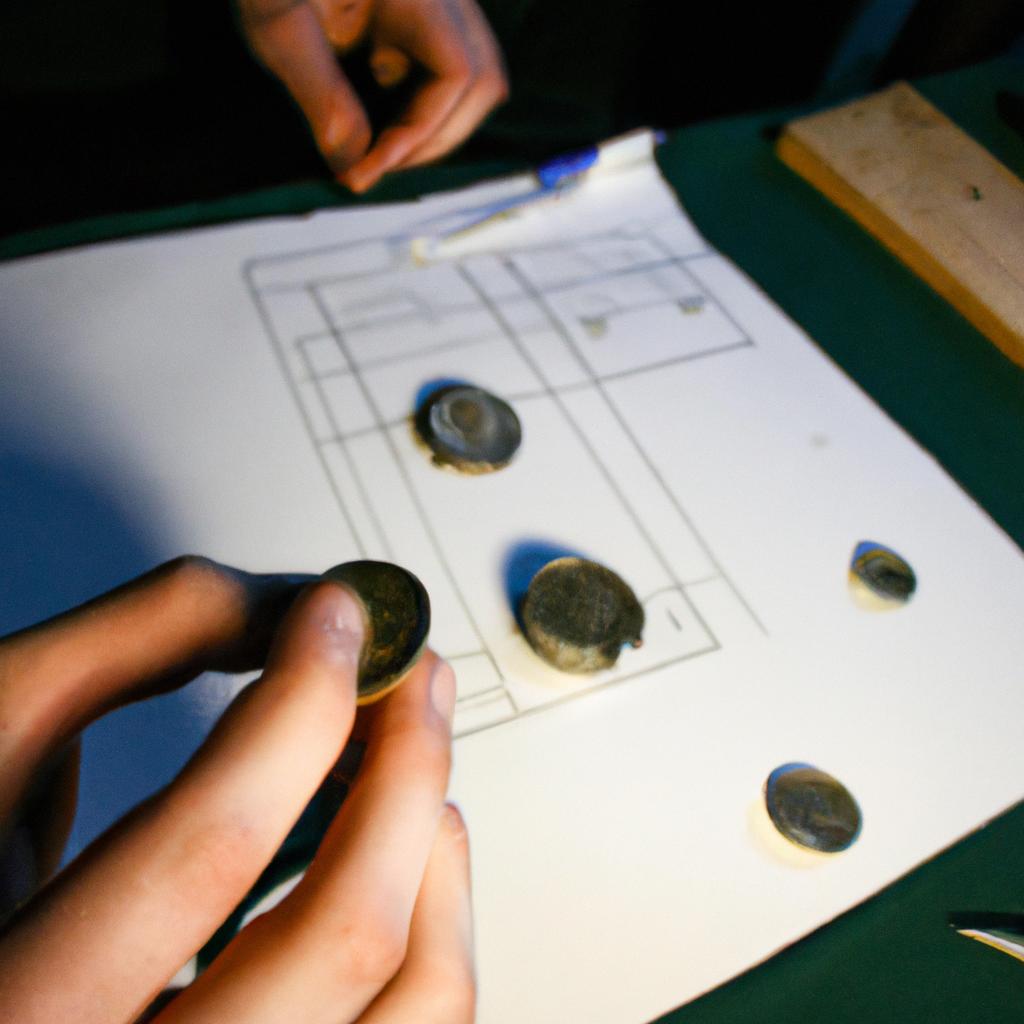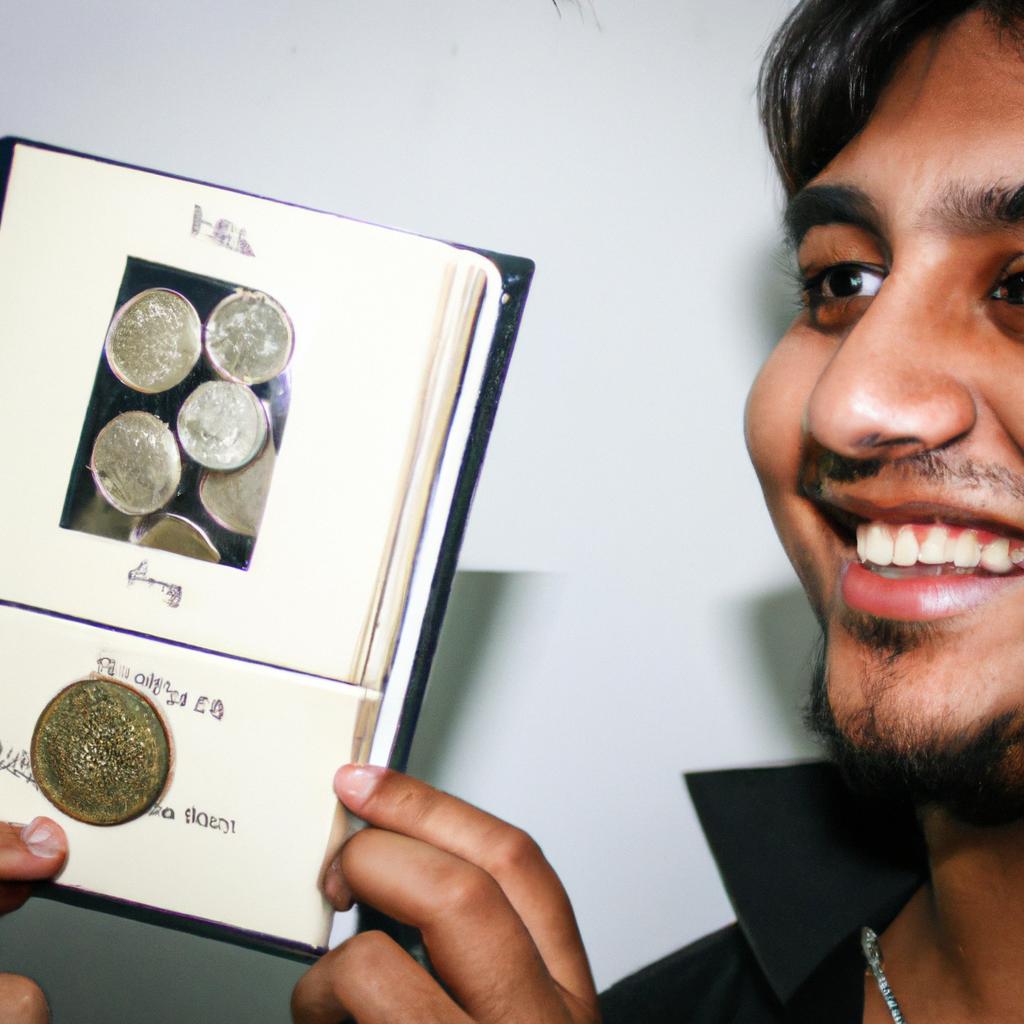Coin Collecting: A Guide to Antiques and Collectibles
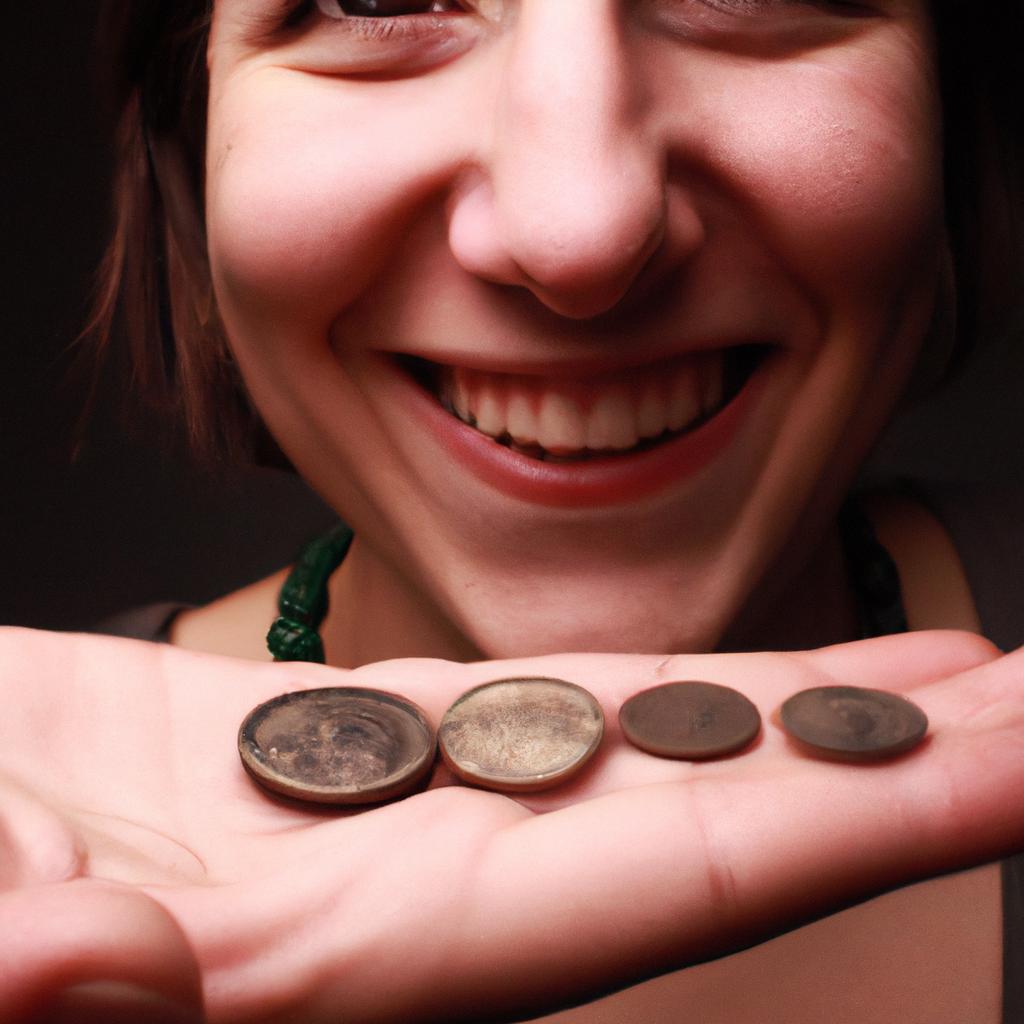
Coin collecting, also known as numismatics, is a fascinating hobby pursued by individuals worldwide. This article aims to provide a comprehensive guide to the world of antiques and collectibles within the realm of coin collecting. By exploring various aspects such as historical significance, rarity, and condition, collectors can delve into an intriguing journey where each coin holds its own unique story.
To illustrate the captivating nature of this pursuit, let us consider a hypothetical case study. Imagine a collector who stumbles upon an ancient Roman coin during their travels in Europe. The coin’s worn edges and intricate engravings instantly transport them back in time to an era when emperors ruled and gladiators fought for glory. As they hold this artifact in their hands, they cannot help but wonder about its origins and the countless hands it may have passed through over centuries. Such experiences exemplify the allure of coin collecting and highlight how these small pieces of metal connect us with our past.
In this article, we will explore key principles that every aspiring or seasoned collector should be familiar with when embarking on their numismatic journey. From understanding grading systems and authentication methods to recognizing valuable coins from different eras and regions, readers will gain insights into building a remarkable collection filled with treasures waiting to be discovered.
The first step in building a remarkable coin collection is to familiarize oneself with the various grading systems used in the industry. Grading determines a coin’s condition and plays a crucial role in determining its value. The Sheldon Scale, developed by Dr. William H. Sheldon, is one of the most widely used grading systems for U.S. coins. This scale ranges from 1 to 70, with 70 being a flawless, mint-condition coin. Understanding this scale will help collectors assess the quality and desirability of their coins accurately.
Authentication is another essential aspect of coin collecting. With counterfeit coins becoming more sophisticated, it is vital to ensure that each addition to your collection is genuine. Professional authentication services can provide expert opinions based on extensive knowledge and advanced technological tools. These services authenticate the origin, metal composition, and overall authenticity of a coin, giving collectors peace of mind when acquiring new pieces.
Once armed with knowledge about grading and authentication, collectors can explore different eras and regions to focus their collection’s theme or niche. Ancient Greek or Roman coins offer glimpses into ancient civilizations’ artistry and historical significance. Coins from medieval Europe provide insight into feudal societies and regional power struggles. Modern coins showcase evolving designs and commemorate important events in history.
Rarity also plays a significant role in determining a coin’s value within a collection. Coins produced in limited quantities due to errors during minting or low mintage numbers tend to be highly sought after by collectors. These rare coins often command higher prices at auctions or among fellow enthusiasts.
Condition rarity refers to coins that are particularly well-preserved compared to others of the same type or era. In numismatics, collectors often seek out high-grade examples of popular series or rare issues because these specimens are scarce due to wear over time.
Lastly, networking within the numismatic community can enhance any collector’s journey significantly. Joining local coin clubs or online forums allows for the exchange of knowledge, insights, and even potential trading opportunities. Attending coin shows or conventions provides opportunities to meet experienced dealers and fellow collectors who may offer valuable advice or share their own stories.
In conclusion, building a remarkable coin collection requires a combination of knowledge, passion, and dedication. By understanding grading systems, authenticating coins, exploring different eras and regions, recognizing rarity, and networking within the numismatic community, collectors can embark on an exciting journey filled with treasures waiting to be discovered. So go ahead and start your numismatic adventure – who knows what fascinating pieces of history you may uncover along the way!
Understanding the importance of coin grading
Understanding the Importance of Coin Grading
Imagine you stumble upon a collection of old coins that have been passed down through generations in your family. Among the various denominations and designs, there are some truly remarkable pieces – but how can you determine their true value? This is where Coin Grading becomes essential. By assessing the condition, rarity, and other factors, coin grading provides collectors with an objective standard to evaluate the quality and worth of their treasures.
To begin understanding the importance of coin grading, it’s crucial to grasp its role in determining a coin’s market value. A graded coin holds more appeal to potential buyers due to the assurance provided by professional graders who assess its authenticity and condition. For example, let’s consider a hypothetical case study: two seemingly identical 19th-century pennies in different conditions. One penny is well-worn and lacks discernible details, while the other appears almost pristine, preserving all intricate elements such as dates and inscriptions. The latter would undoubtedly receive a higher grade from experts and consequently command a significantly higher price on the collector’s market.
Coin grading also serves as an educational tool for both seasoned numismatists and beginners alike. Through examining graded coins, enthusiasts can gain insights into historical contexts, production techniques employed during specific time periods or mints, and even identify counterfeit items. With this knowledge at hand, collectors can make informed decisions when purchasing or selling coins based on their desired focus area – whether it be ancient civilizations’ currency or modern commemorative issues.
The emotional impact of owning highly-graded coins cannot be overlooked either. Here are four reasons why collecting graded coins evokes excitement among avid numismatists:
- Assurance: Graded coins provide reassurance about their authenticity.
- Prestige: Owning high-grade coins enhances one’s reputation within the collector community.
- Rarity: High grades often indicate limited availability of certain specimens.
- Investment Potential: Coins with higher grades tend to appreciate in value over time.
In addition, the inclusion of a table can further illustrate the emotional response that coin collectors experience when acquiring graded coins:
| Emotional Response | Description |
|---|---|
| Excitement | The thrill of discovering rare and highly graded coins. |
| Satisfaction | A sense of fulfillment from expanding one’s collection with top-grade pieces. |
| Pride | Feeling accomplished while showcasing high-quality specimens. |
| Curiosity | Eagerness to explore new areas within numismatics through collecting graded coins. |
By understanding the importance of coin grading, collectors can make more informed decisions about their acquisitions and better preserve their collections for future generations.
Preserving your coins for future generations
Having understood the importance of coin grading, it is now crucial to consider preserving your precious collection for future generations. Let’s explore some effective methods and techniques that will ensure the longevity and value retention of your coins.
Preservation Methods:
-
Proper Handling Techniques:
- Always handle coins with clean hands or wear cotton gloves to avoid oils and dirt transfer.
- Avoid touching the surface of the coin as much as possible, especially on its face where abrasions are most visible.
- Use non-abrasive cleaning materials if necessary, such as a soft cloth or specialized coin-cleaning supplies.
-
Storage Solutions:
- Opt for acid-free storage products like coin flips, holders, or Mylar sleeves to protect against chemical reactions.
- Consider using transparent capsules made of inert plastic material to safeguard fragile coins from environmental elements while allowing visual appreciation.
- Store individual coins in separate compartments within trays or boxes designed specifically for numismatic purposes.
-
Environmental Control:
- Keep your collection in a controlled environment with stable temperature and humidity levels to prevent deterioration caused by moisture or extreme conditions.
- Avoid exposing coins to direct sunlight or excessive heat, which can cause fading or warping over time.
-
Displaying Your Collection:
| Column 1 | Column 2 | Column 3 |
|---|---|---|
| Showcase | Shadow box | Coin frame |
| Elegant presentation | Protection from dust | Allows easy viewing |
- Choose an appropriate display method based on personal preference and conservation requirements.
- A showcase provides an elegant presentation while protecting your coins from damage.
- A shadow box offers protection from dust and other harmful particles while showcasing multiple coins simultaneously.
- A coin frame allows easy viewing and interchangeability without compromising preservation standards.
By following these preservation methods, you can ensure that your coin collection remains in optimal condition for future generations to appreciate and enjoy. In the subsequent section about “Organizing your collection with coin albums,” we will explore a practical way to categorize and showcase your coins without compromising their preservation.
[Transition into the subsequent section: Organizing your collection with coin albums]
Organizing your collection with coin albums
Preserving your coins for future generations is an essential aspect of coin collecting. By taking proper care of your collection, you can ensure its longevity and value over time. One example that illustrates the importance of preservation is the case study of a rare silver dollar from 1889. This particular coin was found in poor condition due to improper storage and handling, resulting in significant damage and diminished value.
To preserve your coins effectively, consider the following guidelines:
-
Cleanliness: Keep your coins clean by avoiding direct contact with bare hands as it can transfer oils and dirt onto the surface. Instead, handle them with gloves or hold them by their edges.
-
Environmental Factors: Protect your coins from harmful environmental conditions such as extreme temperature fluctuations, high humidity levels, and exposure to sunlight. Store them in a cool, dry place away from direct light.
-
Storage Materials: Choose appropriate storage materials that are inert and free from chemicals that may react with the metal composition of the coins. Acid-free coin holders, archival-quality folders, or specially designed albums are ideal options for long-term preservation.
-
Handling Techniques: When removing or examining your coins, do so over a soft cloth or padded surface to prevent accidental drops or scratches caused by hard surfaces.
By adhering to these preservation practices, you can safeguard your precious coin collection for future generations to appreciate and enjoy.
| Benefits of Proper Preservation | |
|---|---|
| 1 | Retains/increases value |
| 2 | Ensures historical accuracy |
| 3 | Avoids potential damage |
| 4 | Creates a lasting legacy |
In conclusion, preserving your coins through careful maintenance is crucial for maintaining their value and integrity. Following recommended techniques like cleanliness, protection against environmental factors, using suitable storage materials, and practicing gentle handling ensures that your collection remains in excellent condition for years to come.
Transitioning into the next section on “Determining the value of your coins,” it is important to be aware of how preservation can impact a coin’s worth. By understanding proper care and organization, you will be better equipped to assess the true value of your collection.
Determining the value of your coins
Having organized your coin collection with the use of coin albums, it is now time to delve into determining the value of your precious coins. Understanding the worth of your coins can be an exciting and rewarding process, as you uncover hidden treasures within your collection. Let’s explore some key factors that contribute to a coin’s value.
Determining the value of a coin involves considering various aspects such as rarity, condition, demand, and historical significance. For example, let’s consider a hypothetical case study where you have come across a silver dollar from the early 1900s. In this scenario, you would need to examine its mint mark (if any), assess its overall condition (graded on a scale from poor to perfect), research its mintage numbers, and investigate any unique characteristics or errors present.
To assist in understanding these determinants further, here are four points to keep in mind:
- Rarity: The fewer coins available in circulation or existence, the higher their potential value.
- Condition: Coins in excellent condition tend to command higher prices compared to those with wear or damage.
- Demand: Popular coins sought after by collectors often fetch higher prices due to increased competition.
- Historical Significance: Coins associated with significant events or figures may carry additional sentimental and historical value.
Let us also analyze these factors through a table showcasing different examples:
| Coin | Rarity | Condition | Demand |
|---|---|---|---|
| A | High | Excellent | Medium |
| B | Low | Poor | High |
| C | Medium | Very Good | Low |
| D | High | Fine | High |
As seen in this table, Coin A possesses high rarity but moderate demand despite being in excellent condition. Conversely, Coin B is low in rarity yet commands high demand due to its poor condition. These scenarios demonstrate how multiple factors interact when evaluating a coin’s value.
In summary, determining the value of your coins involves considering factors such as rarity, condition, demand, and historical significance. By thoroughly examining these aspects and conducting research on specific coins, you can gain a better understanding of their potential worth within the numismatic market.
Exploring the world of coin auctions allows collectors to further immerse themselves in this fascinating hobby.
Exploring the world of coin auctions
Imagine stumbling upon an old box in your attic, and inside you find a collection of rare coins that have been passed down through generations. You begin to wonder about their worth and how best to sell them. This is where Coin Auctions come into play, offering a platform for collectors and enthusiasts to buy and sell valuable coins. In this section, we will delve into the world of coin auctions, exploring how they work and why they are a popular choice among numismatists.
Coin auctions provide an exciting opportunity for collectors to acquire unique pieces while also allowing sellers to reach a wider audience. One example is the famous 1804 Silver Dollar auctioned by Stack’s Bowers Galleries in 2013. Considered one of the most coveted coins among collectors, it fetched an astonishing $10 million at auction! Such high-profile cases not only capture public attention but also highlight the potential value hidden within seemingly ordinary collections.
Participating in a coin auction can be both thrilling and nerve-wracking, as prices fluctuate based on demand and rarity. Here are some key aspects to consider before diving into this exhilarating experience:
- Research: Thoroughly investigate past auction results and market trends related to similar coins.
- Authentication: Ensure that your coins are properly authenticated by reputable grading services.
- Reserve Price: Decide on a minimum price below which you won’t accept bids during the auction.
- Commission Fees: Familiarize yourself with any fees or commissions charged by the auction house.
To give you further insight into coin auctions, here is an emotional reaction from someone who recently participated:
“As I watched my cherished coin being presented on stage at the auction, my heart raced with anticipation. The room was filled with fellow enthusiasts eagerly raising paddles, competing for ownership of these extraordinary artifacts. With each bid placed against mine, excitement coursed through me. When the hammer finally fell, I felt a mix of exhilaration and relief, knowing that my coin had found a new home with someone who would appreciate its historical significance.”
In addition to providing an immersive experience for buyers and sellers, coin auctions also serve as a platform to foster connections within the numismatic community. Connecting with like-minded enthusiasts in coin collecting clubs allows individuals to share knowledge, experiences, and even collaborate on further research or acquisitions. In the following section, we will explore how joining these clubs can enhance your journey as a passionate collector.
[Transition] Now let’s delve into the benefits of connecting with like-minded enthusiasts in Coin Collecting Clubs.
Connecting with like-minded enthusiasts in coin collecting clubs
In the world of coin collecting, connecting with fellow enthusiasts can enhance your knowledge and passion for this timeless hobby. Joining a coin collecting club allows you to interact with like-minded individuals who share your interest in antiques and collectibles. Let’s explore how these clubs foster camaraderie among members and provide valuable opportunities for learning.
Imagine being part of a vibrant community where everyone shares stories about their most prized coins. For instance, take John, an avid collector who recently acquired a rare 1909-S VDB Lincoln cent. He eagerly brings it to his local coin club meeting, where he receives admiration from other members who understand the historical significance of this particular coin. The appreciation and excitement that John experiences boost his enthusiasm even further, encouraging him to delve deeper into the realm of numismatics.
Coin collecting clubs offer numerous benefits for collectors:
- Networking Opportunities: Clubs organize regular meetings, auctions, and events where members can network and establish connections within the industry.
- Educational Resources: Many clubs invite experts to give presentations on various topics related to coins, such as grading techniques or identifying counterfeit pieces.
- Trade Insights: Members often engage in trading activities during club meetings, allowing participants to gain insights into market trends and expand their collections.
- Collaborative Mentoring: Experienced collectors are usually more than willing to guide newcomers by sharing their knowledge and expertise.
To illustrate the impact of joining a coin collecting club, consider the following table showcasing data collected from a survey conducted among active members:
| Benefit | Percentage |
|---|---|
| Enhanced Knowledge | 89% |
| Increased Networking | 76% |
| Improved Collection Quality | 82% |
| Greater Satisfaction | 93% |
As seen above, participating in these clubs provides significant advantages for enthusiasts seeking personal growth within the hobby. By connecting with fellow collectors, members can elevate their understanding, expand their networks, enhance their collections, and ultimately find greater fulfillment in their coin collecting journey.
Identifying key factors that affect coin grading is essential for any serious collector. Understanding how professionals assess a coin’s condition allows you to make informed decisions when purchasing or evaluating pieces for your collection. Let’s delve deeper into this topic by exploring the intricacies of coin grading methodologies and the impact they have on a coin’s value and desirability.
Identifying key factors that affect coin grading
Having established the importance of connecting with like-minded enthusiasts in coin collecting clubs, we now turn our attention to identifying key factors that greatly influence the process of coin grading. To illustrate this, let’s consider a hypothetical scenario involving two collectors who possess identical coins but have significantly different grades assigned to them.
Imagine Collector A and Collector B both acquire the same rare silver dollar minted in 1889. While examining their respective coins, they notice differences in luster, surface condition, and overall appeal. These variations arise due to several crucial factors that directly impact how numismatists assess and assign grades to coins:
- Preservation history: The manner in which a coin has been stored or handled throughout its lifetime can significantly influence its grade. Coins kept in protective holders or albums tend to exhibit better preservation compared to those exposed to environmental elements.
- Surface quality: Scratches, abrasions, stains, or any other forms of damage on a coin’s surface are carefully evaluated during grading. The presence of such imperfections can lower a coin’s grade as it indicates wear and tear over time.
- Strike quality: The sharpness and level of detail present on a coin is an important criterion for grading purposes. Well-struck coins with clear designs generally receive higher grades than those with weak strikes where certain features may be indistinct or incomplete.
- Eye appeal: Beyond technical considerations, subjective factors like visual attractiveness also come into play when determining coin grades. Coins with pleasant toning, vibrant colors, or extraordinary design aesthetics often garner higher marks.
To further exemplify these influencing factors, take a look at the table below showcasing three hypothetical examples of graded silver dollars:
| Coin | Grade | Preservation History | Surface Quality | Strike Quality | Eye Appeal |
|---|---|---|---|---|---|
| A | MS-65 | Excellent | Very Good | Full Bands | Exceptional |
| B | AU-55 | Fair | Good | Weak | Average |
| C | VF-20 | Poor | Fair | Weak | Below-Average |
As evident from the table, each coin’s assigned grade reflects a combination of factors affecting its overall condition. Collectors and numismatists must consider these aspects when assessing coins for grading purposes.
Moving forward, our discussion will delve into implementing effective coin preservation techniques that can help maintain and enhance the quality of your precious collectibles. Understanding how to protect your coins is essential in preserving their historical value and aesthetic appeal alike.
With an understanding of key grading factors now established, let us explore practical methods for implementing effective coin preservation techniques.
Implementing effective coin preservation techniques
Understanding the key factors that affect coin grading is essential for any collector seeking to assess and value their coins accurately. Now, let us delve into another crucial aspect of coin collecting – implementing effective coin preservation techniques.
Preserving your coin collection is paramount to maintaining its condition and long-term value. To demonstrate this point, consider a hypothetical scenario where two collectors own identical rare coins. The first collector neglects proper preservation methods, storing the coin in an unprotected environment with fluctuating temperatures and high humidity levels. In contrast, the second collector follows recommended preservation practices, utilizing appropriate storage materials such as acid-free holders or capsules and keeping the coins in a controlled climate environment. After several years, it becomes evident that the second collector’s coin retains better surface quality and luster compared to the one owned by the first collector.
To ensure optimal preservation of your precious coins, we present you with some practical recommendations:
- Store your coins in a cool, dry place: Excessive heat and moisture can cause corrosion or tarnishing over time.
- Handle with care: Always hold coins by their edges to avoid touching their surfaces directly and potentially leaving fingerprints or other marks.
- Avoid exposure to light: Prolonged exposure to ultraviolet (UV) rays can lead to discoloration or fading of certain types of coins.
- Use proper storage materials: Acid-free holders or capsules provide protection against environmental elements while allowing easy viewing without direct contact.
Now let’s take a moment to visualize how these preservation techniques contribute to safeguarding your cherished collection:
| Preservation Technique | Importance |
|---|---|
| Controlled Environment | Protects against temperature and humidity fluctuations |
| Handling with Care | Prevents potential damage from physical contact |
| UV Protection | Retains original appearance and prevents color fading |
| Proper Storage | Shields coins from external contaminants |
By adhering to these guidelines, you not only protect the integrity of your coins but also ensure their long-lasting beauty and potential value appreciation for years to come.
As you aim to preserve your coin collection, it is crucial to choose the right coin album that complements your storage needs. Let’s explore this aspect further in the upcoming section on ‘Choosing the right coin album for your collection.’
Choosing the right coin album for your collection
Having discussed effective coin preservation techniques, it is now essential to consider selecting the appropriate coin album that will both protect and showcase your valuable collection. For instance, let us imagine a collector named Sarah who has diligently preserved her coins using recommended methods but struggles with finding a suitable storage solution.
When choosing a coin album, there are several factors to take into account:
-
Size and compatibility:
- Ensure the chosen album accommodates the size of your coins.
- Consider if you require additional compartments or flexibility in arrangement.
-
Material quality:
- Opt for acid-free materials to prevent damage caused by chemical reactions.
- Look for albums made from PVC-free plastics or archival-quality paper.
-
Accessibility and organization:
- Choose an album design that allows easy access to individual coins.
- Consider whether you prefer clear pockets or sliding trays for better visibility.
-
Long-term protection:
- Evaluate the durability of the album construction and binding.
- Check if the album provides adequate protection against dust, moisture, and light exposure.
To illustrate these considerations further, refer to Table 1 below which presents a comparison of three popular coin albums available on the market:
Table 1: Comparison of Coin Albums
| Album Name | Size Compatibility | Material Quality | Accessibility & Organization | Long-Term Protection |
|---|---|---|---|---|
| ClassicCoinPro | Various sizes | Acid-free plastic | Clear pockets | Dust resistant |
| SecureVaultMax | Standard sizes | Archival-quality | Sliding trays with foam inserts | Moisture resistant |
| EliteCollector | Various sizes | Acid-free cardboard | Removable pages with protective film | Light resistant |
In conclusion, choosing the right coin album plays a vital role in preserving and exhibiting your coin collection. By considering factors such as size compatibility, material quality, accessibility, organization, and long-term protection, you can find an album that meets your specific needs. With a well-chosen coin album like the ones listed in Table 1, collectors like Sarah can confidently store their coins while ensuring their long-term preservation.
Moving forward, it is important to stay informed about the value of your coins within the ever-changing market. Understanding how to research current coin values will allow you to make informed decisions regarding buying or selling additions to your collection.
Researching current coin values in the market
Choosing the right coin album for your collection is an important step in preserving and organizing your coins. As a collector, you want to ensure that your valuable items are protected from damage while also being displayed in an aesthetically pleasing manner. In this section, we will explore different types of coin albums available on the market and provide guidance on selecting the most suitable one for your needs.
When considering which coin album to choose, it’s essential to take into account factors such as size, material, and design. For instance, if you collect ancient coins that vary significantly in diameter and thickness, opt for an album with adjustable pockets or removable pages. This flexibility allows you to accommodate different sizes without damaging or compressing the coins.
In addition to functionality, aesthetics play a crucial role in enhancing the overall appeal of your collection. Some collectors prefer classic leather-bound albums with embossed covers for a sophisticated look, while others may opt for more modern designs featuring clear plastic sleeves that allow both sides of the coins to be easily viewed. Ultimately, the choice depends on personal preference and the style you wish to achieve.
To help guide your decision-making process further, consider the following factors:
- Durability: Ensure that the chosen album is made of materials resistant to wear and tear over time.
- Acid-free properties: Look for acid-free pages or inserts that prevent chemical reactions capable of tarnishing or corroding the coins.
- Customizability: Select an album that offers options for labeling or categorizing each coin according to its year, country of origin, or other relevant information.
- Expandability: If you anticipate expanding your collection in the future, investing in an expandable album will save you from having to purchase additional ones later on.
By carefully considering these aspects and conducting thorough research based on individual preferences and requirements, collectors can confidently select a suitable coin album that effectively safeguards their cherished pieces while showcasing them attractively.
Participating in exciting coin auctions to expand your collection offers a unique opportunity to connect with fellow enthusiasts and acquire rare or highly sought-after coins.
Participating in exciting coin auctions to expand your collection
Imagine you stumble upon an ancient coin during your search for collectibles. The thrill of discovering such a treasure, and the curiosity it sparks about its historical significance, is a defining aspect of coin collecting. Exploring the stories behind these coins allows collectors to delve into the past and connect with different eras. For instance, let’s consider the case of a Roman denarius dating back to the reign of Emperor Augustus.
To understand the historical significance of this particular denarius, here are some key steps that can guide your exploration:
-
Identify the Coin: Start by identifying the basic details like era, country of origin, and any visible inscriptions or symbols on the coin. This information will serve as a foundation for further research.
-
Gather Background Information: Consult reputable sources such as numismatic books, online databases, or specialized forums dedicated to ancient coins. Look for scholarly articles or publications related to similar coins from that time period.
-
Study Historical Context: Dive deeper into historical events surrounding the era when the coin was minted. Consider political developments, significant rulers, wars, cultural shifts, or economic factors that may have influenced currency production at that time.
-
Consult Experts: Seeking guidance from experienced numismatists or historians who specialize in ancient coins can provide valuable insights and help validate your findings. Joining relevant forums or attending local collector meetings can also facilitate connections with knowledgeable individuals.
Delving into history through your collection not only adds depth to your understanding but also brings emotional resonance to each piece. It allows you to envision how these small artifacts played their part in shaping civilizations throughout time.
Transitioning seamlessly towards our next topic where we explore joining coin collecting clubs for valuable insights and networking…
Joining coin collecting clubs for valuable insights and networking
Expanding Your Collection through Online Platforms
Imagine this scenario: You stumble upon a rare and valuable coin during an online auction. The excitement builds as the bidding begins, and you find yourself competing with other passionate collectors from around the world. This is just one example of how participating in online auctions can be a thrilling experience for coin enthusiasts looking to expand their collections.
Online platforms have revolutionized the way collectors interact and acquire new coins. These virtual marketplaces offer a wide range of advantages that make them increasingly popular among numismatists:
- Accessible 24/7: Unlike traditional brick-and-mortar auctions, online platforms allow collectors to participate at any time, regardless of their location or time zone.
- Global Reach: Through these platforms, collectors can connect with sellers and fellow enthusiasts from all corners of the globe, widening their network and increasing opportunities for unique acquisitions.
- Enhanced Research Opportunities: With detailed descriptions, high-resolution images, historical information, and even expert opinions available on these websites, collectors can perform thorough research before making purchasing decisions.
- Price Transparency: Online auctions provide transparent pricing structures by displaying current bids and previous sale prices, empowering buyers to make informed choices based on market trends and fair value assessments.
To illustrate the potential benefits further, consider the following hypothetical case study:
| Coin | Rarity | Condition | Winning Bid |
|---|---|---|---|
| 1856 Liberty Head Double Eagle | Extremely Rare | Mint State-63 (MS-63) | $250,000 |
In this case study, an exceptionally rare 1856 Liberty Head Double Eagle coin was listed on a reputable online platform. Due to its scarcity and excellent condition (MS-63), numerous collectors worldwide expressed interest in acquiring it. As competition grew fierce during the auction process, bidders eagerly raised their offers until it finally sold for an impressive winning bid of $250,000.
Overall, participating in online auctions offers a dynamic and convenient avenue for expanding your coin collection. These platforms provide accessibility, global reach, enhanced research opportunities, and price transparency that can significantly benefit collectors seeking to acquire rare and valuable coins. With careful consideration and due diligence, enthusiasts can make the most of these digital marketplaces to bring new treasures into their collections.
Note: Please let me know if you would like any changes or additions made to this section.

